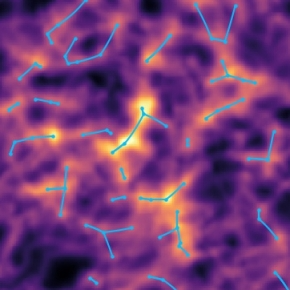Nov 9 2020
According to astrophysicists, nearly 40% of the ordinary matter that forms planets, stars, and galaxies stays undiscovered, hidden in the form of hot gas in the complex cosmic web.

Image Credit: Tanimura, Aghanim (CNRS/University of Paris-Saclay).
For the first time, researchers at the Institut d’Astrophysique Spatiale (CNRS/Université Paris-Saclay) might have now detected this hidden matter by performing a novel statistical analysis of 20-year-old data. The study results were published in Astronomy & Astrophysics on November 6th, 2020.
Galaxies are distributed across the Universe as an intricate network of nodes linked by filaments, which are in turn isolated by voids. This is called the cosmic web.
It is regarded that the filaments comprise nearly all of the ordinary (so-called baryonic) matter of the Universe in the form of diffuse, hot gas. But this diffuse gas emits such a weak signal that in reality, 40% to 50% of the baryons go undetected.
These are the missing baryons concealed in the filamentary structure of the cosmic web, which Nabila Aghanim, a scientist at the Institut d’Astrophysique Spatiale (CNRS/Université Paris-Saclay), and Hideki Tanimura, a post-doctoral researcher, and their collaborators, are trying to detect.
In a new study that was financially supported by the ERC ByoPiC project, the researchers have described a statistical analysis that discloses, for the first time, the X-ray emission from the hot baryons in filaments.
This discovery is founded on the stacked X-ray signal, in the ROSAT survey data, from around 15,000 large-scale cosmic filaments found in the SDSS galaxy survey. The researchers utilized the spatial correlation between the position of the filaments and the related X-ray emission to offer proof for the existence of hot gas in the cosmic web, and to quantify its temperature, for the first time.
The study results validate earlier analyses by the same researchers, which were based on the indirect detection of hot gas present in the cosmic web via its impact on the cosmic microwave background. This provides a method for more elaborate studies, by using better quality data, to investigate the evolution of gas in the filamentary structure of the cosmic web.
Journal Reference:
Tanimura, H., et al. (2020) First detection of stacked X-ray emission from cosmic web filaments. Astronomy & Astrophysics. doi.org/10.1051/0004-6361/202038521.